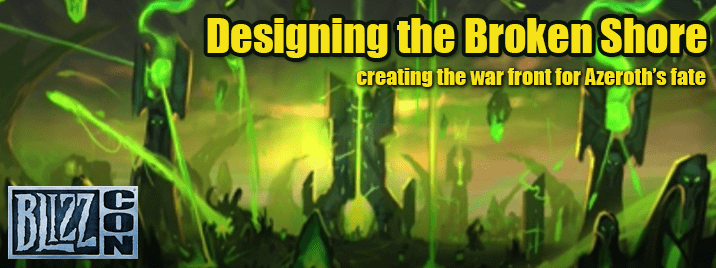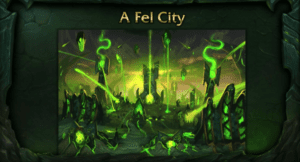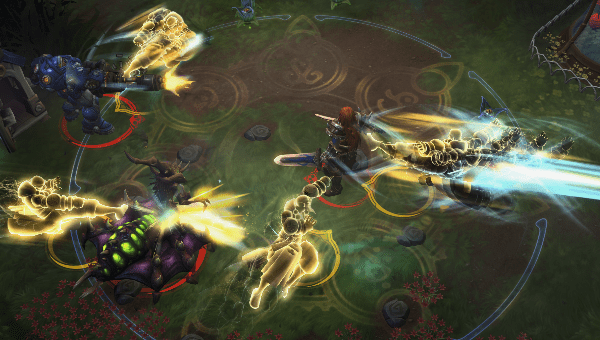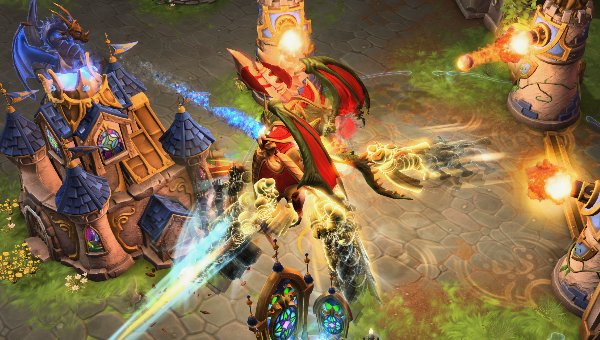
Design Retrospective: Designing the Broken Shore
by Magistrate - 7 years ago show comments
In this short Design Retrospective series, we’ll dissect the the BlizzCon 2016 Design Retrospective panel. Today, we take a deeper look at the creation of the first zone players ever set foot in with the expansion–the Broken Shore–with senior game designer Jeremy Feasel
The Broken Shore–to disambiguate it from the Broken Isles–consists only of that first zone we took on in the pre-patch content. Until now, it has stood vacantly in the shadow of Dalaran, lathered in fel goo, with the Tomb of Sargeras looming on the northern shore.
Back to the Roots
When the team started to develop the Broken Shore, they used two references for how the zone would turn out. First, they looked at the Tomb of Sargeras and surrounding area in Warcraft III. The Broken Shore portion of the isles was once submerged into the ocean, but was raised by Gul’dan in order to get to the tomb. Not surprisingly, its WC3 incarnation sported sea life and aquatic plants.
Secondly, the team looked to the only other zone in any state of completion–Azsuna. A sweeping zone of pale colors and lost Night Elf ruins, it seemed the logical thing to do. After all, the Night Elves had made grand cities in the entire region once–the Tomb is actually a temple to Elune–and it is connected to the Broken Shore by a slightly underwater land bridge.
Thus, the early concepts for the Broken Shore were rife with coral, aquatic plants, and Night Elf ruins that were virtually untouched by time. The early design did have some elements of the demonic activity we recognize today–the fel storm overhead, some demons, and hints of fel magic tucked in the geography. But it was virtually a different zone entirely.
When this early version of the Broken Shore was ready for play testing, internal testers settled in for an opening experience much longer and different than the one we played. For one, the Broken Shore event was three hours long. Besides the difference in themes, the early zone also featured many points where the Alliance and Horde crossed over or near each other.
 Among other things, players would hop into Gnome gyrocopters to obliterate a giant pillar–one would assume it had some kind of Nightborne or Legion function. There was also originally a grand Night Elf city, untouched by the Legion, in which players would encounter Tyrande. Maddened by the spell of Tichondrius and his brothers, players would fight Tyrande to knock her to her senses, after which the Dreadlords’ spell would fade, revealing a desolated ruin instead of a gleaming city.
Among other things, players would hop into Gnome gyrocopters to obliterate a giant pillar–one would assume it had some kind of Nightborne or Legion function. There was also originally a grand Night Elf city, untouched by the Legion, in which players would encounter Tyrande. Maddened by the spell of Tichondrius and his brothers, players would fight Tyrande to knock her to her senses, after which the Dreadlords’ spell would fade, revealing a desolated ruin instead of a gleaming city.
From the colorful coral to the Kaldorei ruins, faction friction and Dreadlords, it all seemed fun–and maybe it was. But, as the entry point into the Legion expansion, the early Broken Shore lacked cohesion.
The team needed to focus on the true story of the expansion–the one that had spread across Azeroth, the one that had brought AU Gul’dan through time and space to the Tomb of Sargeras. And that story was dark, violent, and, most importantly, the largest Legion invasion in the history of Azeroth.
Back to the Drawing Board
They immediately went back to the art team with some fresh ideas. The Legion invasion needed to feel like an invasion–and what invasion was complete without armies, without ships and command centers?
The team began thinking of the invasion in terms of the RTS–units, structures, defensive buildings, and ways to get it all on the ground. Fast. It was an invasion, after all. The Legion had spent more than ten thousand years planning their return (OK, technically the Twisting Nether is timeless), and they would not fail again.
Legion construct ships evolved–monolithic monstrosities surging with fel power. Citadels were drafted. Another cool effect–and one players of the Legion pre-launch event should remember–was how the construct ships would shoot a “seed” of fel magic into the ground, out of which a structure would literally morph and grow. They revisited the ancient Night Elf edifice, the Tomb, and redesigned it as a fountain of the Legion’s power.
 All of these ideas were great, but seeing what was possible made them want to push it further. After all, the Broken Shore was ground zero for the Legion invasion. Kil’jaeden wanted to make a point, send a message–reveal this landscape as the terrible throne of Azeroth’s demise
All of these ideas were great, but seeing what was possible made them want to push it further. After all, the Broken Shore was ground zero for the Legion invasion. Kil’jaeden wanted to make a point, send a message–reveal this landscape as the terrible throne of Azeroth’s demise
They went back to the art team with the words “fel city.” What we got was just that–a vast, dark, desolate landscape rife with demons, fortresses, and evil so potent it could even kill Tirion.
The Broken Shore was born.
Up next: designing the Demon Hunter! And don’t miss all our other great BlizzCon 2016 coverage: Day One | Day Two


